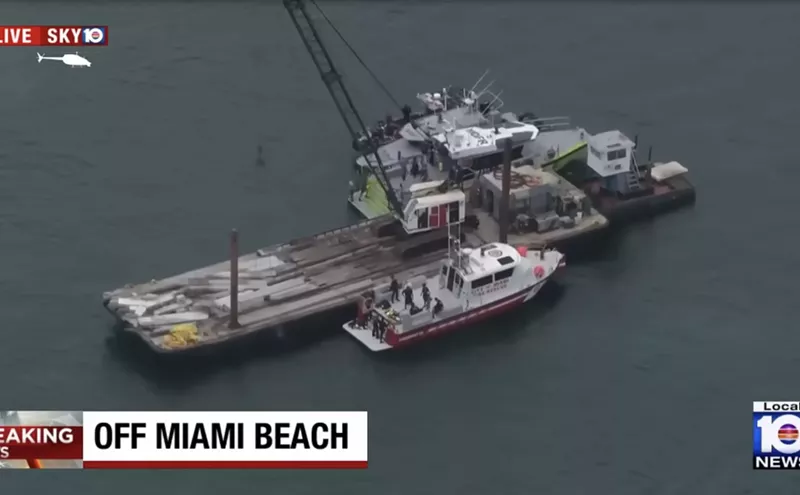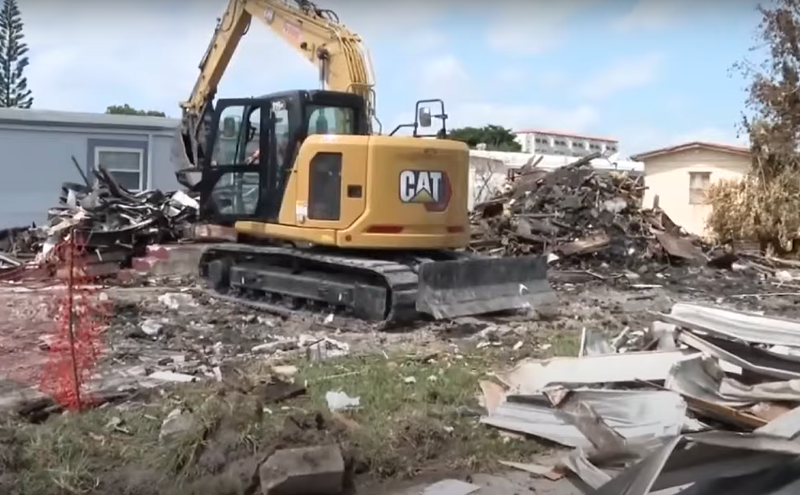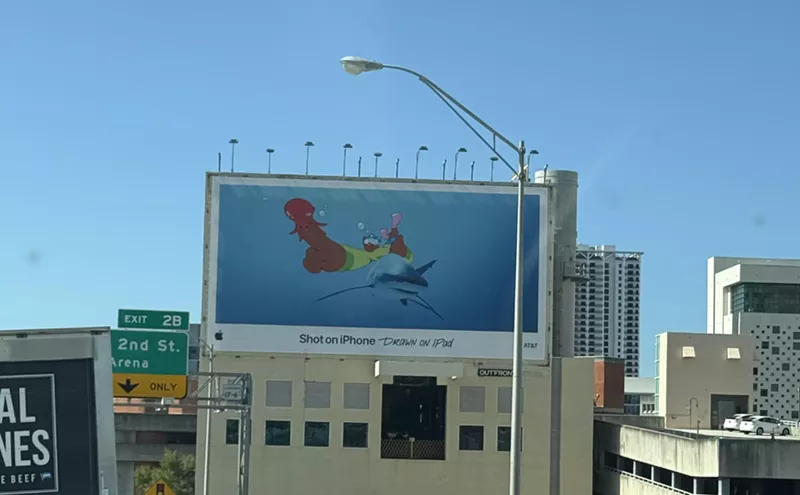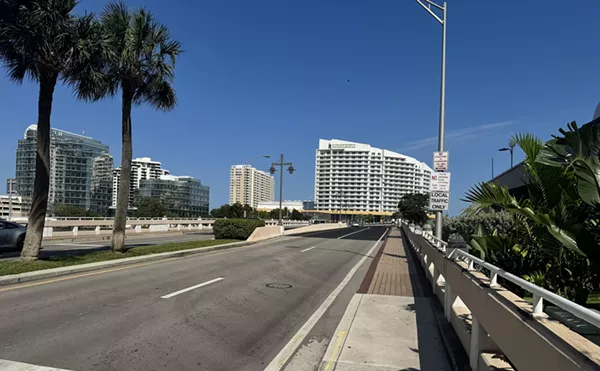Mina Coleman was standing in the driveway of her Tamiami home when she noticed her pack of puppies scrapping over something in the dirt. Vultures circled in the blue sky above. They must have gotten out through that damn hole in the fence again, she thought as she stomped through the backyard. They've probably dug up another dead animal.
When Coleman pulled the dogs apart, however, she didn't find a goat leg or cow rib. Instead, lying in the trampled grass were two bleached bones. Long, thin bones. Human bones.
That was the summer of 1997. Cops would spend weeks investigating, but it would be 14 years before they solved the riddle dug up by Coleman's canines.
Mysterious deaths are common in Miami, a city of runaways and refugees. Each year, several hundred people pass away anonymously — murder victims cruelly stripped of their possessions, bodies burnt beyond recognition, and vagrants found without ID. Doctors, medical investigators, and homicide detectives are left to piece together their identities.
Many cases take only a few days to solve. Some, like the bones in Tamiami, however, torture investigators for years. Between 1956 and 2009, the ranks of Miami's mysterious dead swelled to more than 300.
But in the past four years, new DNA technology has allowed Miami-Dade medical investigators to whittle down this grisly tally, closing at least 16 cold cases including a 15-year-old suicide and a 27-year-old murder. In doing so, coroners have also given closure to families that had long given up on getting answers. "Each body has its own story," investigator Sandra Boyd says. "But it can't begin until we give them a name."
From the outside, the Miami-Dade Medical Examiner Department looks like a sepulcher. The resemblance is fitting. The boxy brick and concrete building is where anyone who dies under traumatic circumstances — a murder, suicide, or car accident, for instance — is delivered before their body can be taken to a funeral home and buried.
In the basement, a team of 11 doctors carves open Miami's dearly departed. The forensic pathologists then slice various organs into tiny cubes for toxicological analysis. They pull blood from lifeless veins and fluid from unseeing eyes. Then the doctors sew the bodies back together.
"Mushy brains," one physician says as he uses what looks like a bread knife to carve up a gelatinous blob. Next to him lies the body of a woman. The top of her head is open like the lid of a bear-shaped bottle of honey. She was in a car accident, the doctor explains. "She never had a chance."
"The work can be a little depressing, so they put in a nice skylight for us," says director of operations Larry Cameron, who kept the salt-and-pepper mustache from his previous job as a school principal.
Cameron walks upstairs toward a vast whirring sound. Inside a fluorescent-lighted room are scores of spinning, beeping machines, each one busy analyzing the tissue samples taken in the basement. "This is the lab where the test was run on the infamous MacArthur Causeway guy," Cameron says, referring to Rudy Eugene, the man called the Miami Zombie, who was shot and killed by police last Memorial Day weekend after he ate another man's face. The test results showed Eugene was high on marijuana, not bath salts, as had been widely speculated.
Identifying the dead, however, is a more difficult task than detecting drugs. Jane and John Does are assigned a number and kept in 40-degree coolers, sometimes for years. But they still slowly decompose. State law forbids the cremation of unknown remains, so some skeletons are eventually stripped of their flesh and moved to the "bone room," a vault full of tiny cardboard coffins. Other bodies are buried in Galloway Cemetery, a small park in Southwest Miami-Dade where numbered bricks serve as headstones.
There, the bodies lie until Boyd or Miami-Dade police catch a break.
One such break came in November 2011, when Miami resident Iris Allen was looking through the National Missing and Unidentified Persons System (NamUs). As she clicked through the thousands of ghostly images, she suddenly stopped at a snapshot of a man's back tattoo: three black gothic crosses. When she called Miami-Dade police to ask about the photo, they told her they had found the 23-year-old man shot to death in 2006. She told them the man was her son, Shahmaal Allen.
Allen had been buried months earlier in Galloway Cemetery, but Boyd had saved some of his blood just in case. She sent the sample to a high-tech lab at the University of North Texas. The results confirmed Allen was the murder victim. Cops are now investigating the case.
Scientists' ability to mine decades-old DNA for information has helped solve dozens of other cold cases, from that of Karlyle Berry, an Iraq War veteran who shot himself in a Cutler Bay field after struggling to find a job, to Angel Soto, a drug addict who was found floating in a canal under Florida's Turnpike.
Sometimes the wait for DNA results can be torturous. When Boyd told Soto's mother that the tests had to be repeated, the woman berated her. "There's no way that you can dangle people on and on for months and months and months," Michelle Soto wrote. "It's absolutely outrageous." When the results finally came in, however, Soto was apologetic. "My son is finally on his way home, and for that I thank my God... and each one of you for making that possible."
In the unluckiest of cases, families and investigators conduct their own parallel investigations for decades — cops and coroners searching for clues to identify an unknown body; sons and daughters or mothers and fathers searching for a sign of what happened to their loved one — until fortune, and DNA, finally connect them.
That's what happened last year when a dismembered body discovered in 1985 was finally identified as Nilsa Padilla. (The case was described in the May 9, 2013 New Times cover story, "Memories of Murder.") Padilla's daughter said she had witnessed the killing when she was a child. But it took more than two decades for her horrific story to be taken seriously. When cops finally reopened the case, scientists tested the 27-year-old bones, and the results came back a match. Police are now looking for Padilla's killer.
Even that saga, however, seems simple compared with the fate of the bones that Mina Coleman's dogs discovered in Tamiami in 1997. At first, Coleman didn't think much of the find. She threw the bones on top of her carport to keep them away from the dogs and then forgot about them.
Eight months later, however, her father happened to be talking to Dr. Joe Davis, then the Miami-Dade medical examiner. Davis asked to look at the bones. When Coleman pulled one down, Davis immediately recognized it as a man's femur.
Cops used police dogs to search the adjacent woods. But after several days, all they could find were animal carcasses. It would be another year before the body would be found.
On April 27, 1999, two men were surveying an overgrown lot near Coleman's house when they spotted something strange: a noose dangling from a tree. Underneath it lay a human skull. This time, cops found the skeleton and confirmed it belonged to the same body as the bones Coleman's dogs had discovered.
Even with an entire skeleton, it would take 12 years for technology to catch up to the case. In the meantime, family members fruitlessly searched for signs of Victor Murgado. The handsome, mustached Cuban had paddled himself to Miami on a raft in September 1995. But he grew frustrated that he couldn't find a job. On January 17, 1996, Murgado left his wallet on the kitchen counter of his cramped trailer. He was last seen riding away on a black bicycle with chrome fenders.
On July 28, 2011, the University of North Texas lab finally matched a bone sample taken by Boyd to DNA taken from Murgado's family. The two parallel mysteries snapped together into one sad, seamless story. On that cool January day 15 years earlier, Murgado was pedaling along when he spotted a shady copse of Australian pine. He stopped his bicycle, walked across the soft carpet of fallen needles, and slung a rope around the bough of a solitary melaleuca tree. Then, in a fit of depression, he hanged himself.












